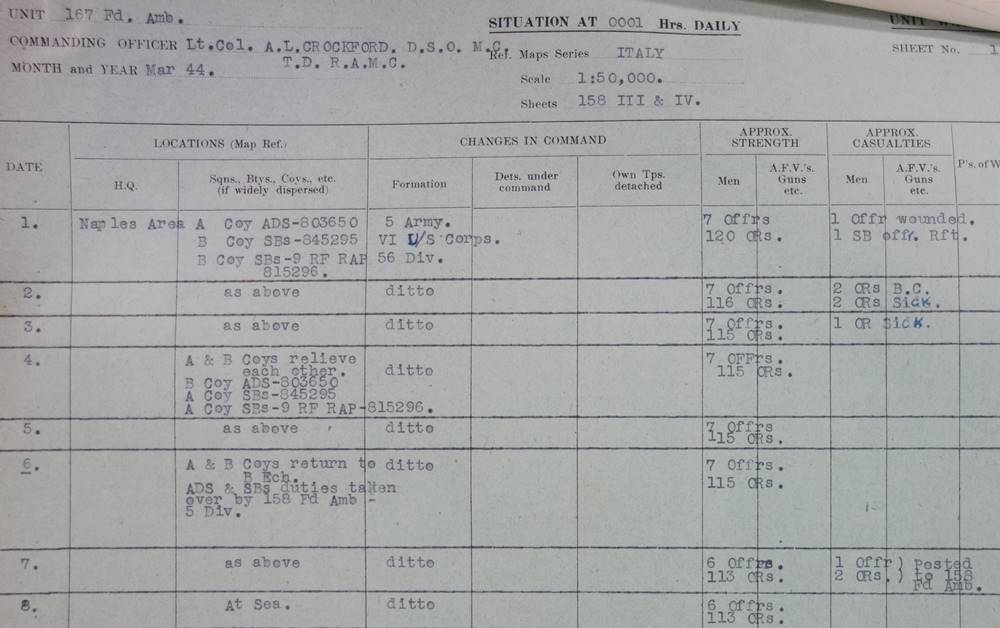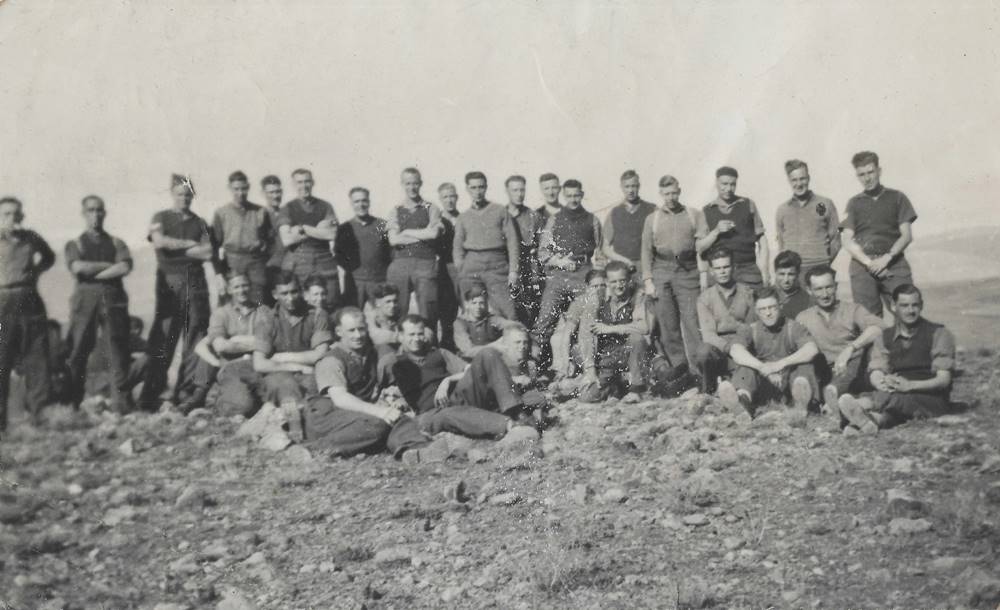This article looks at the role of a field ambulance of the Royal Army Medical Corps during the Second World War. As well as explaining what a field ambulance was, this article will help you research them and the soldiers who served with them. This is one of a series of articles I’ve written to help you in your research:
I also offer a Second World War Soldier Research and Document Copying Service.
Field Ambulance Royal Army Medical Corps
A field ambulance was a mobile medical unit of the Royal Army Medical Corps which was usually found serving with an infantry division during the Second World War. Each infantry division had three field ambulances and they usually worked closely with one of the formation’s infantry brigades. They could also be found serving as corps troops. A soldier who was ill, wounded or had been in an accident would often pass through a field ambulance and the abbreviation F.A. is frequently found in service records. The exact role of a field ambulance in evacuating soldiers depended on where it was serving and whether the formation it was involved with was in action.
Many units had a regimental aid post, manned by a Medical Officer from the Royal Army Medical Corps. If a soldier became ill or was wounded, they would usually be sent to a regimental aid post first. Here, only limited medical assistance could be offered and most soldiers were sent on to the next step in the casualty evacuation chain which was a field ambulance. A soldier sent to a field ambulance was placed on the X(ii) List as they left their unit for medical treatment. If a field ambulance was serving in Britain or away from the front line, it would often be concentrated in a single location, with a couple of small detachments in the area. However, if the formation in which it was serving was in action, it would be dispersed with one or more advanced dressing stations. These operated close to the front line and evacuated casualties back to the main dressing station which was located further away. A field ambulance could also attach Stretcher Bearers to attacking infantry battalions which cleared wounded from the battlefield, a very dangerous task.
After a casualty reached the main dressing station, they would often be sent to a casualty clearing station which was usually located many miles away. However, if a soldier could be expected to recover their wound or illness relatively quickly, they were often kept in a field ambulance before being posted back to their unit. This was especially the case in Britain or away from active operations when a field ambulance didn’t have to worry about patient capacity. A field ambulance often worked with a motor ambulance convoy of the Royal Army Service Corps to evacuate these casualties but also had its own ambulances to evacuate wounded. As well as personnel from the Royal Army Medical Corps, each field ambulance had a number of soldiers attached from the Royal Army Service Corps who drove and maintained its vehicles. The photograph below shows the Royal Army Service Corps detachment of 215th Field Ambulance at Kantara in Syria in February 1942. As over thirty men appear in the photograph, the majority of the 215th Field Ambulance’s Royal Army Service Corps soldiers appear.
War Establishment of a Field Ambulance
The following war establishment, II/1931/16/2 was “Notified in Army Council Instructions for the week ending 8th July, 1936” and was replaced by II/1931/16/3 in June 1940. The latter establishment was very similar. There were further changes during the war.
A field ambulance was divided into a headquarters and two companies, lettered A and B. Those serving with the headquarters provided “personnel and equipment for a main dressing station” while the companies provided “stretcher bearers and equipment for an advanced dressing station”. Twelve officers served with a field ambulance, including an officer from the Army Dental Corps, Royal Army Chaplains’ Department and Royal Army Service Corps. Though, the Chaplain wasn’t always allotted to a field ambulance, so often there were only eleven officers.
A Lieutenant-Colonel commanded a field ambulance, with a Major or Captain usually in charge of the companies. The Royal Army Service Corps officer attached to a field ambulance was either a Lieutenant or Second Lieutenant. Six officers served with the headquarters and three with each company. There were 222 other ranks serving with a field ambulance with 100 serving with the headquarters and 61 in each company. Of the other ranks serving with a field ambulance, 42 were attached from the Royal Army Medical Corps. This gave a field ambulance a total strength of 234 all ranks.
These figures include soldiers from the Royal Army Service Corps who were attached to a field ambulance. Most of the Royal Army Medical Corps soldiers who served with a field ambulance were trained as Nursing Orderlies but there were also a small number of Clerks, Dispensers and Cooks, along with a Carpenter and Joiner. For transport, a field ambulance had eight cars, five motorcycles, three vans, eighteen lorries, two trailers, and eight 6-wheeled ambulances. These figures should be seen as a guideline only, as there were a lot of shortages early in the war.
How to Research a Field Ambulance
The most important document to research a field ambulance will be its war diary. This was written by an officer of a unit and recorded its location and activities. They often contain appendices in the form of orders, field returns of officers and other ranks, maps etc. and are held at the National Archives in London. Most of the war diaries concerning field ambulances are part of the WO 177 series of Army Medical Services war diaries. This series contains just under 3,000 war diaries and includes over 300 field ambulances diaries. You need to be careful as there will often be a British and Indian field ambulance with the same number. There are also East African, West African, and light field ambulances. The field ambulances of the Royal Army Medical Corps have catalogue references between WO 177/675 and WO 177/835. There are also two Malaya field ambulances, with one, 4th Field Ambulance’s catalogue reference WO 177/681. A field ambulance will have between one and three war diaries covering their service and I offer a copying service for these documents.
Another source of information for a field ambulance is the war diary of the Assistant Director of Medical Services of the division they were serving in. This war diary will contain information about all of the Royal Army Medical Corps units serving with that division. It is particularly useful if a field ambulance’s war diary is missing a lot of appendices as they will often be duplicated in an Assistant Director of Medical Services’ war diary. While there are orders of battle for the Royal Army Medical Corps at the National Archives, the quickest way to check the formation a field ambulance served with during the war is Orders of Battle Second World War by Lieutenant-Colonel H. F. Joslen. The formation a field ambulance was serving in will also be recorded in its war diary. Below is an extract from the 167th Field Ambulance’s daily situation report for March 1944 when the unit was serving in Italy. This useful document is usually found from 1944 onwards when a unit was serving outside of Britain. The 167th Field Ambulance was recorded as serving with the 56th (London) Division. Therefore, if you wanted to find out as much information as possible about the 167th Field Ambulance, you would also need to check the war diary of the Assistant Director of Medical Services of the 56th (London) Division.

Most field ambulances worked closely with a single brigade of a division which offers another source of information in the war diaries of its three infantry battalions. These will be most useful when a brigade was in action and especially if a field ambulance attached its stretcher bearers to an infantry battalion. If a field ambulance took part in active operations in a theatre of war, it may have worked closely with a motor ambulance convoy whose war diary could be another source of information. The motor ambulance convoy a field ambulance was working with will often be mentioned in their war diary. Another source of information for a field ambulance is the gallantry and award citations of its soldiers which are available to download from the National Archives’ website as part of the WO 373 series. There is a small fee to download each citation but they are free to download at the National Archives.
How to Research a Soldier who Served with a Field Ambulance
Without a soldier’s service record, they are usually impossible to research unless you happen to know which field ambulance/s they served with and when. A service record is usually the only place to find such information unless you’re researching a soldier who you already have a large quantity of documentation for or an officer. Even then, a service record will contain a lot of information which can’t be found elsewhere. Without knowing which field ambulance a soldier served with, you won’t be able to know which war diaries to consult to find out where they served. service records for soldiers who served in the British Army during the Second World War are held either by the Ministry of Defence or National Archives and I’ve written a guide to ordering a copy.
There are only a handful of digitized resources available online which may be of use. One of the most important are the War Office casualty lists for 1939-1945 which are available to search on Findmypast. These record soldiers who died, were wounded, went missing or captured during the war. A soldier will be recorded by their personal or army number followed along with the rank, surname, initials and often the unit they were serving in when they became a casualty. Though, the casualties may just be listed as Royal Army Medical Corps. Casualty lists are easiest to search if you already know a soldier’s number. Once you have the date a casualty occurred and the unit a soldier was serving in at the time, you can turn to that field ambulance’s war diary to find out more information. Findmypast also has a selection of prisoner of war records and the British Library’s digitized newspaper collection. The latter is an important resource to research if you’re researching a casualty. Unfortunately, only a small portion of British newspapers from the period have been digitized so far.
If the soldier you’re researching was awarded a gallantry medal or honour, you can download and search for their citation in the National Archives WO 373 series. These are available to download for free if you register first. If a soldier was mentioned in despatches, then you can try to find their entry in the London Gazette, though the search system is very poor. The London Gazette can also be used to find the date an officer was commissioned and subsequent promotions. The Commonwealth War Graves Commission will record where a soldier who died between 3 September 1939 and 31 December 1947 is buried or commemorated. Additional information will also be recorded, including the date they died, their number and often the exact unit they were serving in at the time. Though, Royal Army Medical Corps may be recorded instead of the exact unit. If this is the case, try searching the casualty lists on Findmypast.

